
Supreme Court Justice O’ Connor Headlines Commencement 2003 | Two Professors Join GW Law Faculty | Top Honors | GW Law Inaugurates Richey Award | GW Law Hosts Japanese Justice | Immigration Clinic Scores Victory | Former Honduras Ambassador Visits GW | Experts Discuss Competitive Sourcing | Novel Features GW Law Student | Mock Trial, Moot Court Test Student Skills | Brazilian Ambassador Opens Enrichment Series | Dean Visits Japan, Korea | Revisiting Brown v. Board of Education
Supreme Court Justice O’ Connor Headlines Commencement 2003
 |
|
Photo by: Abdul El-Tayef/WPPI
|
Thousands of celebrants, family members, and friends packed GW’s Charles E. Smith Center on Sunday, May 25, for GW Law’s 136th commencement. Nearly 500 graduates—including 410 newly-minted JDs, 82 master of laws recipients, and one graduating doctor of judicial science—received their degrees, along with honorary doctor of laws degree recipient Supreme Court Justice Sandra Day O’Connor, who also served as keynote speaker.
In her insightful, candid remarks, O’Connor challenged the Class of 2003 to volunteer their time to represent people who cannot afford legal assistance. “The gap between the need for legal assistance and the ability to pay for it seems to be widening,” she said. “I hope that every single graduate of this law school today will take some of the opportunities that certainly will come your way to perform some pro bono legal services for others in need. No legal service for which I was paid gave me greater satisfaction than simply helping someone who needed it without expectation of financial compensation.”
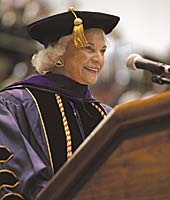 |
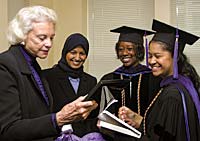 |
|
Photos by: Abdul El-Tayef/WPPI
|
O’Connor continued, “There is sad evidence all across the nation that a substantial number of our citizens believe our legal and judicial system is unresponsive to them because of racial bias; that too often equal justice is but an unrealized slogan. Use your skills acquired here to help provide both the perception and the reality of equal justice under law.”
The justice urged GW Law graduates to “aim high, be full participants in life’s opportunities, and to join in trying to leave the world a little better than you found it on your arrival.”
The first woman to serve as a U.S. Supreme Court justice, O’Connor was appointed to the court by President Ronald Reagan in 1981. A moderate conservative, she is regarded as an independent and strong-willed jurist who often mediates between those on both sides of the political spectrum.
Highlights of her long and distinguished career include serving as assistant attorney general of Arizona from 1965 to 1969 and serving two terms on the Arizona State Senate. O’Connor was the first woman in the United States to hold the position of state Senate majority leader in 1972. Her judicial career began in 1975, when she was elected to the bench of the Arizona Superior Court in Maricopa County, and, in 1979, to the Arizona’s highest court, the Court of Appeals.
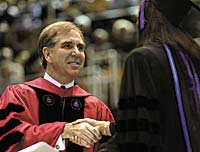 |
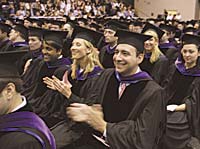 |
|
Photos by: Abdul El-Tayef/WPPI
|
At GW Law, O’Connor joins an elite list of legal and political luminaries who have addressed commencement ceremonies, including Chief Justice of the United States William Rehnquist; The Hon. Harry A. Blackmun, retired U.S. Supreme Court associate justice; and former Attorney General Janet Reno.
As always, a special highlight of commencement was the awarding of honors to outstanding faculty members, staff members, and graduates. Olamide “De” Famuyiwa, JD ’03, outgoing Student Bar Association president, represented his classmates in presenting the Distinguished Faculty Service Award to Professor Paul D. Butler. The 2003 Adjunct Faculty Teaching Award went to The Hon. Randall R. Rader, JD ’78, Larry E. Ray, and Stephanie Ridder. Roseanne O’ Hara, director of academic support services, received the Law School’s first Distinguished Staff Service Award.
GW Law School Dean Michael K. Young presented awards to three outstanding students. John L. Kammerer, JD ’03, received the John Bell Larner Award for earning the highest cumulative grade point average in his class. The Anne Wells Branscomb Award went to Matthew B. Kaplan for attaining the highest cumulative average in the evening program. The entire graduating JD class voted Famuyiwa the recipient of the Michael Dillon Cooley award.
Young also conferred emeriti status on Professors of Law Frederick J. Lees, Robert E. Park, and David Robinson Jr., who combined have served 98 years in legal education.
—Jamie L. Freedman
Two Professors Join GW Law Faculty
GW Law welcomes two new full-time faculty members this year:
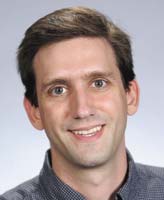 Thomas Colby
Thomas Colby
Associate Professor Law
After graduating from law school, Colby interned in the Office of the Solicitor General, and then clerked for Judge Guido Calabresi of the U.S. Court of Appeals for the Second Circuit and Supreme Court Justice David H. Souter. He then practiced constitutional and tort law in the Supreme Court and appellate practice group of Mayer Brown & Platt’s Washington office, and served as a Bigelow Fellow and Lecturer in Law at the University of Chicago Law School. His research and teaching interests include constitutional law, torts, federal courts, civil procedure, and legal history.
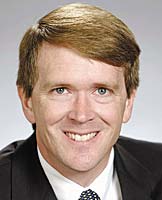 John Fitzgerald Duffy
John Fitzgerald Duffy
Professor of Law
After receiving an undergraduate degree in physics, Duffy served as articles editor on the University of Chicago Law Review and was awarded an Olin Fellowship in Law and Economics. He clerked for Judge Stephen Williams on the U.S. Court of Appeals for the D.C. Circuit and for Supreme Court Justice Antonin Scalia. He served as an attorney-adviser in the Department of Justice’s Office of Legal Counsel and practiced law with the Washington firm of Covington & Burling. Since entering academia in 1996, Duffy has been on the faculty of the Benjamin N. Cardozo School of Law and the William and Mary School of Law, and also has served as a visiting professor at the University of Chicago. He has published articles in the University of Chicago Law Review, Columbia Law Review, Texas Law Review, and Supreme Court Review, and is the co-author of a casebook on patent law. Duffy teaches torts, administrative law, patent law, and international intellectual property law.
Top Honors
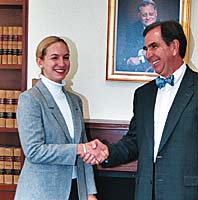 |
|
Alina Morris with Dean Young
Photo by: Paul Fucito
|
Sponsored by the American Society of Composers, Authors, and Publishers, a performing rights organization, the 2003 Nathan Burkan Memorial Competition honors ASCAP founder and attorney Nathan Burkan and calls for papers written on aspects of copyright law. Professor Roger Schechter encouraged his copyright and trademark students to apply to the competition, and a GW Law student and an alumna took top honors for their essays.
Alina Suzanne Morris, a third-year law student, drew on her experiences as executive articles editor for the American Intellectual Property Law Association Quarterly and her part-time internship in an international copyright firm to craft her essay, Copyright and Musical Improvisation: A Balance Between Legal Protection and Promoting the Creative Process Requires Maintaining the Current Scheme. As a string bass musician who often relied on improvisation in her high school and Boston College jazz bands, she chose to write about creativity and copyright in her work.
Morris’ achievement was celebrated by Dean Michael K. Young, who met with Morris to congratulate her on the accomplishment.
Michelle Mattis, JD ’03, was also a winner of the competition. Mattis lives in New York where she practices with Hogan & Hartson.
GW Law Inaugurates Richey Award
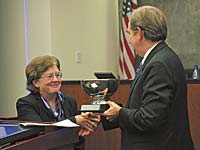 |
|
Dean Young presents the Richey Award to Judge Wald.
|
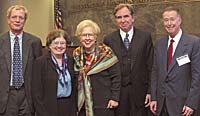 |
|
Charles Richey (son of Charles R. Richey), Judge Patricia Wald, Mardelle Richey, Dean Michael K. Young, Professor Stephen Saltzburg
|
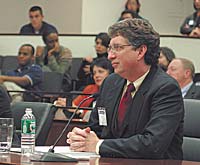 |
|
(below) Associate Dean Susan L. Karamanian gave an introduction to set the stage for the moot court case. (above) Professor Ralph Steinhardt, a presenter in the moot court case, awaits his turn in front of a full house in the Moot Court Room.
Photos by: Abdul El-Tayef/WPPI
|
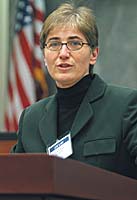 |
The Law School presented its inaugural Charles R. Richey award to former federal judge and former International Criminal Tribunal judge Patricia McGowan Wald Nov. 6.
The award presentation followed a moot court and discussion relating to alleged war crimes during the U.S. intervention in Iraq.
After a welcome from Dean Michael K. Young, Professor Stephen Saltzburg gave opening remarks about Charles R. Richey and the award. Appointed in 1971 to the U.S. District Court in Washington, D.C., Richey was known for his commitment to civil rights and equal justice, as well as his tight control in the courtroom—with the maxim he often quoted, “justice delayed is justice denied.”
Associate Dean of International and Comparative Legal Studies Susan L. Karamanian provided an introduction to the moot court problem. Professor Ralph Steinhardt and David Scheffer, former U.S. ambassador at large for war crimes issues, presented arguments, while Wald presided over the case. The event was covered by the Arab Aljazeera network.
At the conclusion of the moot court and discussion, Young presented the inaugural Charles R. Richey Award to Wald. After 20 years on the federal bench, Wald retired in 1999. She served as chief judge of the U.S. Court of Appeals for the District of Columbia Circuit from 1986 to 1991. After retirement, she accepted an appointment to serve on the 14-member panel of judges of the International Criminal Tribunal in The Hague, where she spent two years hearing cases on wartime crimes in the former Yugoslavia. She now serves as chair of the Open Society Institute’s Criminal Justice Initiative.
Although Richey was not an alumnus of GW, he has ties to the school. He appointed Saltzburg special master in the Hartman class action case, which spanned much of the judge’s career. And Dennis Davison, BA ’71, once clerked for Richey. Wald was selected as the first recipient of the award because of her commitment to the rule of law, and civil and human rights that the award symbolizes.
Mardelle Richey (Charles Richey’s wife), and Charles Richey (his son), also were present and were recognized at the event by Davison. A reception outside the Moot Court room followed the events.
GW Law Hosts Japanese Justice
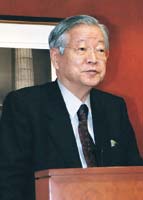 Retired Japanese Supreme Court Justice Itsuo Sonobe spoke at an October luncheon attended by GW Law faculty members, international LLM students, and foreign visiting scholars. Sonobe’s remarks, which addressed legal reform in Japan, focused on imminent changes in Japanese legal education. While learning about the legal system in Japan, the attendees were able to reflect on the legal system in the United States as well.
Retired Japanese Supreme Court Justice Itsuo Sonobe spoke at an October luncheon attended by GW Law faculty members, international LLM students, and foreign visiting scholars. Sonobe’s remarks, which addressed legal reform in Japan, focused on imminent changes in Japanese legal education. While learning about the legal system in Japan, the attendees were able to reflect on the legal system in the United States as well.
“Justice Sonobe’s presentation provided clear insight into key issues affecting the Japanese legal system and included comparative elements that caused us to look differently at the U.S. legal system,” says Associate Dean for International and Comparative Legal Studies Susan L. Karamanian.
The evening before the luncheon, Japan’s ambassador to the United States, Royzo Kato, and his wife hosted a dinner in honor of Sonobe. Supreme Court Justice Antonin Scalia, Dean Michael K. Young, Karamanian, and lawyers from the Japanese Embassy also attended the dinner.
Immigration Clinic Scores Victory
The GW Law School Immigration Clinic added another triumph to its record in April, helping an Ethiopian man attain legal asylum in the United States after five years of waiting here without status.
The client, a member of the All Amhara People’s Organization, was arrested by Ethiopian authorities in 1994 after a political demonstration and detained in abusive conditions for three months. After his release, he came to the United States and sought asylum without legal assistance, filing a self-prepared asylum application in 1996. It was denied by the Asylum Office in January 1998, and his case was sent to Immigration Court for removal proceedings.
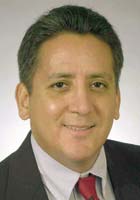 “He was typical in many ways,” says Professor of Clinical Law Alberto M. Benitez, director of the GW Immigration Clinic. “He had an application for asylum that he had done on his own, without the assistance of an attorney. That’s usually a bad thing.”
“He was typical in many ways,” says Professor of Clinical Law Alberto M. Benitez, director of the GW Immigration Clinic. “He had an application for asylum that he had done on his own, without the assistance of an attorney. That’s usually a bad thing.”
But the case didn’t end there. Right after his application was denied in 1998, he approached the GW Immigration Clinic to appeal the decision before the Board of Immigration Appeals in Arlington, Va.
Immigration Clinic student Todd G. Willis, JD ’99, compiled the case and represented the client before Judge Joan V. Churchill in September 1998.
“It really was a top-notch claim,” Benitez says. “He just did an amazing amount of work. He did everything a lawyer does. Unfortunately, it was denied.”
The court denied the client’s second application for asylum at the end of the hearing. Benitez said the damage done by the client’s innocent first attempt made the appeal an even greater challenge, because the first application remained part of his file.
“Very often, people who try to put together the application alone spend the majority of the application talking about general country conditions,” Benitez says. “Solid claims are about the applicant. It may be somewhat graphic, but the application needs to be rather detailed about what persecution was suffered, how it took place, and who inflicted it.”
The client claimed he was beaten on his back and feet, burned with a hot iron, and repeatedly raped by a guard while in prison. Willis documented medical evidence to support his client’s physical injuries and the resulting emotional trauma.
In summer 1999, Benitez wrote a brief appealing his client’s rejection to the Board of Immigration Appeals, arguing against the denial of the GW-prepared application. In a rare move, a BIA panel reversed the lower court’s decision in April 2003 and issued an order granting the client asylum.
“That’s not common in any court,” Benitez says. “It’s more common for an appellate board to say the first judge didn’t do it properly, and issue a remand, sending it back to that judge to do over.”
Benitez blames “typical” bureaucracy for the three-year delay in approving the client’s third and successful application.
In April 2004, the client can adjust to lawful permanent resident status, and in five years he will be eligible to naturalize to U.S. citizenship.
Benitez said Washington attracts a high number of asylum-seeking immigrants because of its urban environment, earning GW’s Immigration Clinic greater attention.
“I think there’s an increased interest in the clinic,” he says. “GW’s clinic is unique because it’s one of the oldest in the country, and it remains the only true immigration clinic in the D.C. area.” Benitez says GW is alone in representing claims for Adjustment of Status, which helps immigrants obtain a green card to establish lawful permanent residence in the U.S., and Cancellation of Removal, which helps aliens facing expulsion by the Office of Homeland Security.
“That’s where I think our clinic is really important,” Benitez says. “The kinds of people who apply for these things don’t have a lot of money, and the private bar needs fees to survive. We can take cases they simply can’t take, even though they would like to.”
The clinic was founded in 1979 and gives law students who have completed the Immigration Law survey course an opportunity to get into court.
“We win most of our cases,” Benitez says. “When someone walks into an immigration court represented by GW, it means it’s a case to take seriously.”
—Amanda Mantone
Former Honduras Ambassador Visits GW
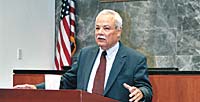 Former U.S. Ambassador to Honduras Cris Arcos, who is currently senior adviser of foreign policy and director of international affairs for the Department of Homeland Security, visited campus in October. As a guest of the Hispanic Law Students Association to celebrate Hispanic Heritage Month, Arcos presented “Latinos and U.S. Foreign Policy” in the Jacob Burns Moot Court Room. He discussed his opinion that Latinos in the United States have not fully mobilized in their involvement with U.S. foreign policy. Arcos encouraged greater unity and effectiveness through education and representation.
Former U.S. Ambassador to Honduras Cris Arcos, who is currently senior adviser of foreign policy and director of international affairs for the Department of Homeland Security, visited campus in October. As a guest of the Hispanic Law Students Association to celebrate Hispanic Heritage Month, Arcos presented “Latinos and U.S. Foreign Policy” in the Jacob Burns Moot Court Room. He discussed his opinion that Latinos in the United States have not fully mobilized in their involvement with U.S. foreign policy. Arcos encouraged greater unity and effectiveness through education and representation.
“It was a fascinating talk that really brought light to the need of Latinos to band together to have some influence on international policy,” says HLSA member and law student Patricia Manteiga, who helped organize the event.
Experts Discuss Competitive Sourcing
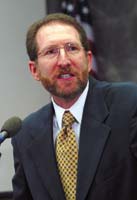 |
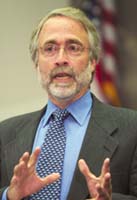 |
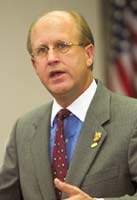 |
|
(left) Panel Moderator, Professor Steve Schooner, Co-Director of the Government Procurement Law Program, The George Washington University Law School. (center) Paul C. Light, Paulette Goddard Professor of Public Service, New York University, and Douglas Dillon Senior Fellow, Brookings Institution. (right) David M. Walker, comptroller general of the United States
Photos by: Abdul El-Tayef/WPPI
|
On Sept. 15, The Law School welcomed the comptroller general of the United States, David M. Walker, for a thought-provoking discussion of the “Future of Competitive Sourcing.” Walker discussed the principles underlying the Bush administration’s competitive sourcing policy. The policy, under which government employees compete with the private sector to perform certain functions, has the potential to dramatically change the nature of government. While he acknowledged the potential that salutary competition could improve the quality of government services and might save taxpayer money, Walker expressed grave concerns over the use of quotas for the replacement of government workers with contractor employees.
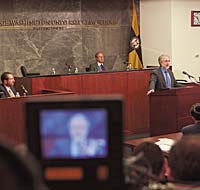 |
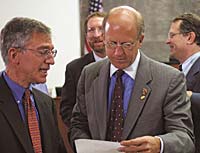 |
|
(top) C-SPAN Coverage of the event
(above) Professorial Lecturer Daniel I. Gordon with David M. Walker (Program Co-Directors Schooner and Joshua I. Schwartz in background)
Photos by: Abdul El-Tayef/WPPI
|
Walker was joined by Paul Light, a Brookings Institution fellow and public policy professor at New York University, whose empirical work on the true size of government plays an important role in the ongoing “outsourcing” debate. Light articulated that the current policy has little to do with how many people perform the government’s missions and everything to do with who those “public servants” will be. In other words, the true size of government cannot be measured by counting civil servants or soldiers. Light’s research leaves no doubt that, despite steady decreases in the number of government employees spanning more than a decade, the federal government employs no fewer people to perform its ever-expanding mandates.
Professor Steve Schooner, co-director of GW Law’s Government Procurement Law Program, moderated the discussion. Schooner suggested that significant impediments—ranging from pending legislation to the inadequate planning and insufficient numbers of qualified procurement personnel—may deter successful implementation of the competitive sourcing policy.
The program, presented by the Government Procurement Law program, was underwritten by law firm Holland & Knight. C-SPAN broadcast the event live from the Law School’s Moot Court Room. Essays from this colloquium will appear in a forthcoming issue of the Public Contract Law Journal. The next program in the series, which was scheduled for November, was to address emerging issues in the suspension and debarment of government contractors.
Novel Features GW Law Student
 Best-selling author Tony Hillerman wove a piece of GW into his newest mystery novel, penning a GW Law student in The Sinister Pig, the latest installment of his Leaphorn and Chee suspense series, published by HarperCollins in May 2003.
Best-selling author Tony Hillerman wove a piece of GW into his newest mystery novel, penning a GW Law student in The Sinister Pig, the latest installment of his Leaphorn and Chee suspense series, published by HarperCollins in May 2003.
Hillerman is author of more than 20 books, including 15 mysteries in the popular Leaphorn and Chee series. His interest in Southwest history and culture has been the basis of most of his novels, with plots blending Native American culture and its clash with modern society.
The Sinister Pig unravels the mystery of an unidentified corpse discovered on the edge of a natural gas field in Navajo country. When the FBI quickly takes over the investigation from tribal police, Navajo sergeant Jim Chee grows suspicious. Chee and lieutenant Joe Leaphorn believe the murder was related to a billion-dollar embezzlement of Indian Tribal royalty trust money by the Department of the Interior.
Chee unearths information that could put him in danger as he discovers ties to wealthy, powerful Washington lawyer and lobbyist Winsor Rawley. A fictitious GW Law student named Chrissy, who works for Rawley, begins to discover the same disturbing information and finds herself in even greater danger.
The author spins a riveting plot, leaving readers guessing about what the mysteriously murdered man was looking for among the pipes of the San Juan Basin’s gas field, and whether any of his characters can solve the murderous puzzle without losing their lives.
Hillerman said he decided to use the GW Law School in his new story because he knows several of its graduates.
“I used it because I consider it, judging from alumni I know, to be quite different from the Ivy League schools whose graduates I know,” Hillerman says. “I use Harvard, and other Ivy League institutions, as the producers of my intellectual snobs; born rich, bad guys who provide the villains of my books.”
He said he wanted Chrissy to be a GW student who worked part time so she would be a character that readers can relate to.
“That makes her my kind of people, as opposed to the prep-schoolers with somebody else paying their expenses,” Hillerman says.
GW Law School Dean Michael K. Young, a Hillerman fan, says he is pleased with the exposure Hillerman has given to GW Law.
“I think he’s really on to something,” Young said. “GW students are hard-working. We have a lot of first-generation law school students. They tend not to view law school as an entitlement so much as an opportunity.”
A Harvard Law alumnus who has taught at Columbia University, Young says Hillerman is correct in calling GW students different from those at Ivy League institutions.
“I’ve seen these other schools. GW students are interested in making the world better,” Young says. “More GW Law graduates go into government and public interest work than any other school in the country.”
Hillerman earned a journalism degree from the University of Oklahoma, where he grew up surrounded by Native American culture, and worked for 17 years as a newspaper reporter and editor. He was a journalism professor at the University of New Mexico for 20 years and was the president of the Mystery Writers of America.
—AM
Mock Trial, Moot Court Test Student Skills
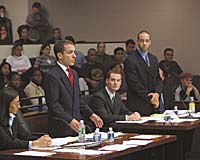 |
|
(above) Students at work during the October Cohen & Cohen Mock Trial Competition
(below) Robert Johnston (Spriggs & Hollingsworth) and Jonathon Spaeth (Akin Gump Strauss Hauer & Feld) served as judges.
Photos by: Abdul El-Tayef/WPPI
|
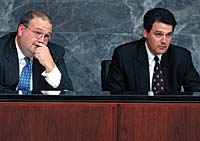 |
The Mock Trial Board held its annual Cohen & Cohen Mock Trial Competition in October in front of a full house in GW Law’s Jacob Burns Moot Court Room. The competition was the capstone event for the fall semester for the Law School’s Mock Trial Board.
Last year, the board had five teams participate in external competitions. One GW team won the regional championship in the Association of Trial Lawyers of America’s Student Trial Advocacy Competition. Another GW team finished the National Trial Competition as regional co-champions and went on to compete in the NTC Nationals, placing among the top 25 teams in the country.
The board thanks all alumni who participated. Any alumni interested in judging the spring competition, scheduled for Feb. 21, should contact Rupali Patel at rpatel@law.gwu.edu or Shanna Singh at ssingh@law.gwu.edu.
This year, the board also is sponsoring five teams in fall external competitions. For the first time, all five teams will be assisted by a formal coach, who will provide guidance and support to the teams in the months leading up to the competitions, including traveling with the teams during the competitions.
The board is always looking for experienced alumni to help the teams. Anyone who is interested in coaching one of the spring teams should contact Rohan Virginkar at rvirginkar@law.gwu.edu.
The Moot Court Board also is sponsoring several other competitions during the spring semester, including the Giles Rich Intellectual Property Law Competition, the Jessup International Law Competition, the National Security Law Competition, the McKenna, Long & Aldridge Government Contracts Competition, and the First Year Competition. Alumni who are interested in serving as judges should contact Alison Levin at alevin@law.gwu.edu or James Cobb at jcobb05@gwu.edu. Lawyers with a background in national security law who are interested in judging this year’s National Security Law Competition should contact Andre Mura natlsecurity@law.gwu.edu.
The board also will have at least four teams competing in external moot court competitions hosted throughout the country.
Earlier this year, GW Law hosted the first round of the Van Vleck Constitutional Law Moot Court Competition. More than 60 competitors argued issues abortion and capital punishment. The final round of the competition will be held Feb. 8 in the Marvin Center. Judge Frank Easterbrook of the U.S. Court of Appeals for the Seventh Circuit will be presiding as chief judge. All alumni are invited to attend. Please contact Don Amlin at damlin@law.gwu.edu with questions about the competition.
Brazilian Ambassador Opens Enrichment Series
 Brazalian Ambassador to the United States Rubens Antionio Barbosa gave the opening lecture for the 2003-04 Enrichment Program at the Law School in October. Now in its 23rd year, the program was established to enhance the extracurricular intellectual life of GW Law students.
Brazalian Ambassador to the United States Rubens Antionio Barbosa gave the opening lecture for the 2003-04 Enrichment Program at the Law School in October. Now in its 23rd year, the program was established to enhance the extracurricular intellectual life of GW Law students.
In November for the Enrichment Program, the Law School hosted John Kamm, executive director of The Dui Hua Foundation, a San Francisco-based organization dedicated to improving human rights in China.
Dean Visits Japan, Korea
|
Dean Michael K. Young journeyed to South Korea and Japan during the summer to visit with alumni and dignitaries, and to make presentations about the state of the Law School.
|
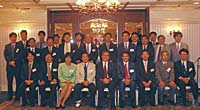 |
Dean Michael Young meets with the newly formed Tokyo Chapter of The George Washington University Law School Alumni Association, at its annual meeting.
|
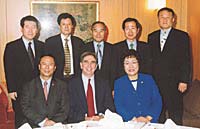 |
In South Korea, Dean Michael Young met with alumni and other dignitaries. Pictured here, back row: Kwangil Baik, Joong Kim, Shin Wook Kang, Kwang Il Joo, Yoon Young Oh. Front row: Young Kyun Kim, congressman; Dean Michael K. Young; Jung Sook Kim, congresswoman.
|
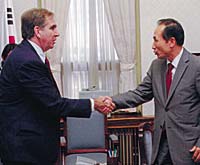 |
Dean Young visits with Seoul Mayor Lee Myung-bak.
|
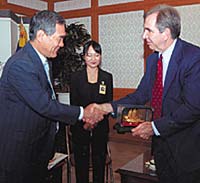 |
Dean Young visits with the chief justice of the Korean Supreme Court, Jong Young Choi.
|
Revisiting Brown v. Board of Education
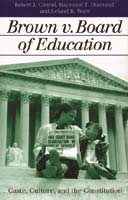 As U.S. courts continue the debate over affirmative action in the 21st century, one GW Law professor takes a closer look at race relations today and its origins in the landmark 1954 court case, Brown v. the Board of Education of Topeka.
As U.S. courts continue the debate over affirmative action in the 21st century, one GW Law professor takes a closer look at race relations today and its origins in the landmark 1954 court case, Brown v. the Board of Education of Topeka.
In the recently-released book Brown v. Board of Education: Caste, Culture and the Constitution (University Press of Kansas, 2003), Professor Robert J. Cottrol joins two other African-American legal scholars, Raymond T. Diamond of Tulane University and Leland B. Ware of the University of Delaware, in writing a history of the case that takes a new step toward examining its effect on modern America.
“One of the things we do in the book is we treat it as a cultural and social history as well as a legal one,” says Cottrol, who is a professor of law, history, and sociology and is the Harold Paul Green Research Professor of Law. “You can’t discuss the legal changes that occur without taking into account the issue of race that occurs in the 21st century.”
The book, designed for law and history students as well as the general public, explores the idea of race as a caste in American society, borrowing from studies of the caste system on the Indian subcontinent.
“The notion of caste is the idea of being hermetically sealed in some way, the idea that caste and race are immutable. Blacks sealed in different categories,” Cottrol says. “Today I think we’re in something of a flux; it’s unclear. There are some people with blond hair and blue eyes who still have ‘Negro’ written on their birth certificate.”
He says it is difficult to gauge the state of race relations in the 21st century because people increasingly identify themselves in biracial categories, something he sees as a change from just 20 years ago.
“We used to adhere to a ‘one-drop’ notion of race,” he says. “It’s more open to debate today.”
Cottrol says he built the book’s foundation on his earlier experiences writing about race struggles in New England. Author of The Afro-Yankees: Providence’s Black Community in the Antebellum Era and From African to Yankee: Narratives of Slavery and Freedom in Antebellum New England, Cottrol said this background proved helpful in writing about racial equality. The 1850 Roberts v. City of Boston case first declared segregated schools constitutional, paving the way for the 1896 Plessy v. Ferguson “separate but equal” ruling that held until 1954. Homer Plessy was only one-eighth black.
The book goes on to give a history of the case and the litigation strategies that brought it into court. Cottrol says the book shows how the law evolves and discusses the different factors involved in such a difficult decision.
“Brown v. Board is a tremendously important case, in some ways the most important Supreme Court case ever done,” Cottrol says. “I was trying to look at it really as a case that, in some ways, helped define the nation’s experience with race. That old notion of immutability is still with us.”
—AM